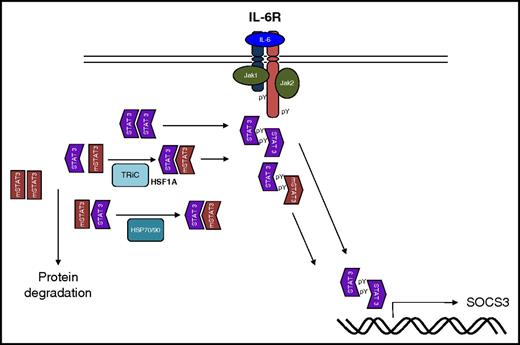WT and mutant STAT3 are able to form homodimers and heterodimers. WT homodimers are phosphorylated downstream of cytokine receptor complexes and translocate to the nucleus where they act as transcription factors. In HIES, some mutant copes of STAT3 result in misfolded protein that are cleared together with any associated WT STAT3. HSPs are able to reverse this, restoring STAT3 function. mSTAT 3, mutant STAT3; pY, phosphorylated on tyrosine; SOCS3, suppressor of cytokine signaling 3; TRiC, tailless-complex polypeptide-1 ring complex.
WT and mutant STAT3 are able to form homodimers and heterodimers. WT homodimers are phosphorylated downstream of cytokine receptor complexes and translocate to the nucleus where they act as transcription factors. In HIES, some mutant copes of STAT3 result in misfolded protein that are cleared together with any associated WT STAT3. HSPs are able to reverse this, restoring STAT3 function. mSTAT 3, mutant STAT3; pY, phosphorylated on tyrosine; SOCS3, suppressor of cytokine signaling 3; TRiC, tailless-complex polypeptide-1 ring complex.
Job or hyper-IgE syndrome (HIES) is a multisystem immunodeficiency characterized by dermatitis, recurrent fungal and staphylococci infections of the skin and lungs together with disorders of connective tissue including joint hypermobility, bone fractures, retained primary teeth, and craniosynostisis.2
In 2007, pathogenic heterozygous mutations in the STAT3 gene were described.3 Those are found in the majority of patients with classical HIES. The link with STAT3 would explain a number of characteristic features of HIES. HIES patients have a relative lack of interleukin-17 (IL-17)-secreting T helper cells,4 which are implicated in defense against extracellular bacteria and fungi.5 Loss of IL-6, IL-21, and IL-23 signaling contributes to immune defects and defective IL-11 signaling to the skeletal phenotype.6 Remarkably, the remaining STAT3 activity in multiple signaling cascades is sufficient to prevent additional pathology. For instance, to allow leukemia inhibitory factor signaling to achieve placental implantation. No homozygous loss-of-function mutations have been described in humans, and homozygous STAT3 deficiency in mice is embryonically lethal.7
STAT protein dimers are recruited to cytokine receptor complexes and are activated by phosphorylation of their tyrosine residues. The phosphorylated protein dimers undergo a conformational change and translocate to the nucleus to bind target gene promoter and enhancer elements8 (see figure). This activation by phosphorylation has led to the assumption that total STAT3 protein matters little to overall STAT3 signaling and that loss of a single STAT3 gene allele is unlikely to be of consequence.
The STAT3 mutations in HIES are exclusively heterozygous and tend to affect either the DNA-binding or Src homology 2 (SH2) domains of the protein. Mutations in the SH2 domain result in a protein dimer that is unable to be adequately phosphorylated at the cytokine receptor complex, and mutations in the DNA-binding domain result in a protein dimer that is unable to efficiently bind target gene loci. As the active STAT transcription factor works as a heterodimer or homodimer, this has given rise to the assumption that STAT3 mutations associated with HIES act in a dominant-negative manner. Measurements of lymphocytes from patients with HIES have demonstrated a 75% reduction in STAT3 activity in patients with mutations in the DNA-binding region of STAT3 in keeping with the stoichiometric assumption that 75% of STAT3 dimers would contain a mutant copy of STAT3 either as homodimer or heterodimer.4
In their current work, Bocchini et al looked at 77 identified mutations of STAT3 linked with HIES and propose a novel mechanism by which HIES-associated mutations restrict STAT3 signaling. Computer modeling suggested that 20 of these mutations would result in a structurally unstable misfolded protein and a further 42 were predicted to impair both protein stability and function. They confirm that mutations, predicted to destabilize STAT3 protein, resulted in a shortened STAT3 protein half-life in Epstein-Barr virus (EBV) transformed B-cell lines derived from HIES patients. Furthermore, activation of the heat shock pathway reduced STAT3 misfolding and was able to correct the functional impairment associated with many STAT3 mutations associated with HIES. One of the small molecules investigated that induces the heat shock protein (HSP) pathway, geranylgeranylacetone, has long been used in Japan as an antiulcer drug, raising the possibility of its use in the treatment of some forms of HIES and other diseases associated with impaired STAT signaling.
Mutations that give rise to unstable proteins are hard to equate with a dominant-negative effect assuming a model where mutated monomers are cleared leaving behind the stable wild-type (WT) protein. The authors counter this assumption, although they only provide indirect evidence that the presence of a mutant allele results in a reduced stability of any associated WT allele, as total STAT3 protein has a reduced half-life in EBV cell lines derived from patients. They suggest that as STAT3 exists as a dimer in the inactive unphosphorylated form, clearance of the misfolded form results in a bystander reduction in any associated WT STAT3. This again does not explain why the residual 25% of STAT3 that would be expected to exist as a WT dimer does not simply remain and accumulate to maintain an adequate supply of protein.
An alternative hypothesis would conclude that despite the critical role played by tyrosine phosphorylation and DNA binding for the activity of STAT3, the level of total protein plays another important contributory role by setting the threshold for available protein. According to this interpretation, some mutations that give rise to HIES cause a haploinsufficiency disorder9 rather than a simple dominant-negative disorder. The distinction is not merely academic as agents that increase total STAT3 protein, as suggested by the authors, will only work if they give rise to functional protein. Thus, the findings by Bocchini et al places some genetic forms of HIES into the growing spectrum of haploinsufficiency disorders that present with immune defects9 which has clear implications for the treatment of this immunodeficiency.
Conflict-of-interest disclosure: The authors declare no competing financial interests.


This feature is available to Subscribers Only
Sign In or Create an Account Close Modal